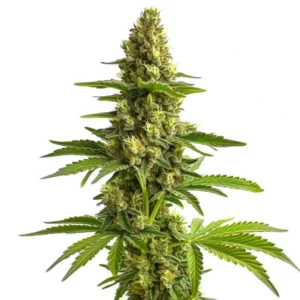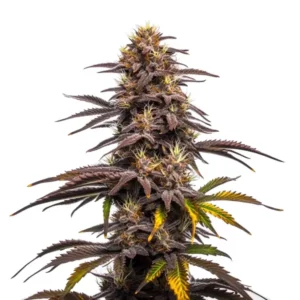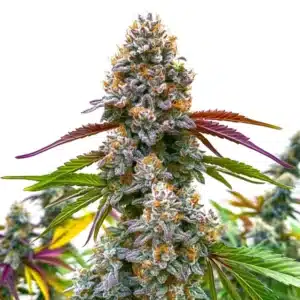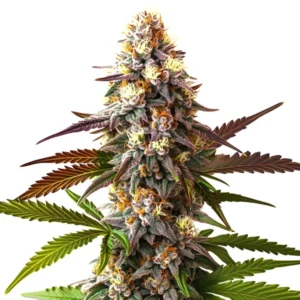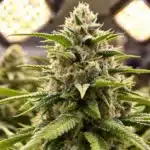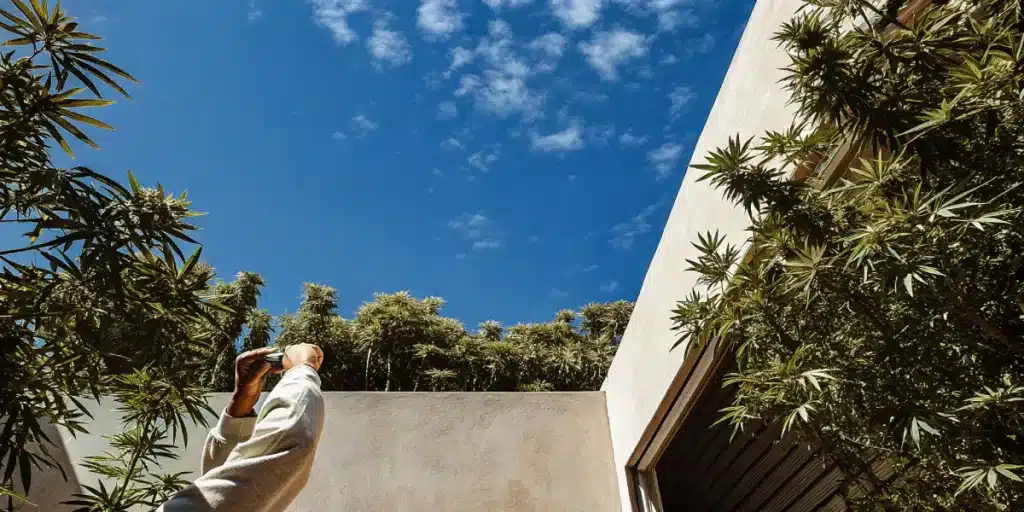
Cannabis Topping Guide for Beginners
Starting with cannabis growing can be thrilling yet challenging. If you’re here, you’re already a step ahead in learning about plant training. This cannabis topping guide for beginners explains how topping enhances growth and boosts yield. For first-time growers, it might seem intimidating, but with this guide, you’ll find the process simple and effective.
Think of topping as giving your plant a haircut. By cutting the top of the plant, you encourage it to grow more branches. This results in a bushier plant with more buds. This method is favored by experienced growers because it maximizes light exposure and space efficiency.
Recommended Strains
Bruce Banner #3
|
|
THC | 20% - 29% (High) |
|
|
Type | Feminized |
|
|
Yield | Medium |
|
|
Phenotype | 50% Indica / 50% Sativa |
Girl Scout Cookies
|
|
THC | 18% - 25% (Medium) |
|
|
Type | Feminized |
|
|
Yield | High |
|
|
Phenotype | 60% Indica / 40% Sativa |
Before diving into the practical steps, it’s crucial to choose the right strains. Some strains react better to topping than others. For example, feminized strains like Bruce Banner 3, Girl Scout Cookies, and Critical Daddy Purple from Blimburn Seeds are known for their resilience and productivity when topped.
What is Topping and Why Do It?
Topping is a pruning technique that involves cutting the main stem of the cannabis plant. This encourages the plant to develop multiple colas instead of one. Colas are the flowering sites that eventually produce buds. More colas mean more buds, and who wouldn’t want that?
For novice growers, the idea of cutting their plant might be daunting. But fear not, it’s a simple process that can significantly boost your yield. Think of it as training your plant to grow better and more efficiently. It’s a cornerstone technique in any cannabis topping guide for beginners.
Understanding the purpose of topping is crucial in the beginner’s guide to topping cannabis plants. By redirecting the plant’s energy, you not only enhance yield but also improve the plant’s overall health. This technique ensures that your plant’s growth is balanced, preventing it from becoming too tall and spindly.
Moreover, topping can help in creating a more manageable plant structure, which is particularly beneficial for indoor growers with limited space. By promoting lateral growth, you allow your plant to fill out horizontally, making full use of the available light and space. This structural advantage is one of the key reasons why many growers include topping in their cannabis cultivation practices.
Promos & Deals
When to Top Your Cannabis Plant
Timing is everything in the world of cannabis cultivation. The best time to top your cannabis plants is during their vegetative stage. This is when the plant is growing rapidly and can recover quickly from cutting. Typically, you want to top after the plant has developed 3 to 5 nodes.
A node is where leaves and branches extend from the stem. By waiting until your plant has multiple nodes, you ensure it’s strong enough to handle the topping process. For first-time growers, patience is key. If you top too early, your plant might not recover as well.
Another critical factor in deciding when to top is the overall health of your plant. Ensure that your plant is healthy and free of any stress before you perform topping. A stressed plant may not recover as efficiently, which can jeopardize your yield. Observing these cannabis plant topping tips for novice growers can make a significant difference in your results.
Additionally, consider the environmental conditions when planning to top your plants. Ideally, the plant should be in a stable environment with consistent temperatures and humidity levels. Abrupt changes in these conditions can add stress to the plant, making the recovery from topping more challenging. These considerations form part of the best practices for topping cannabis for beginners.
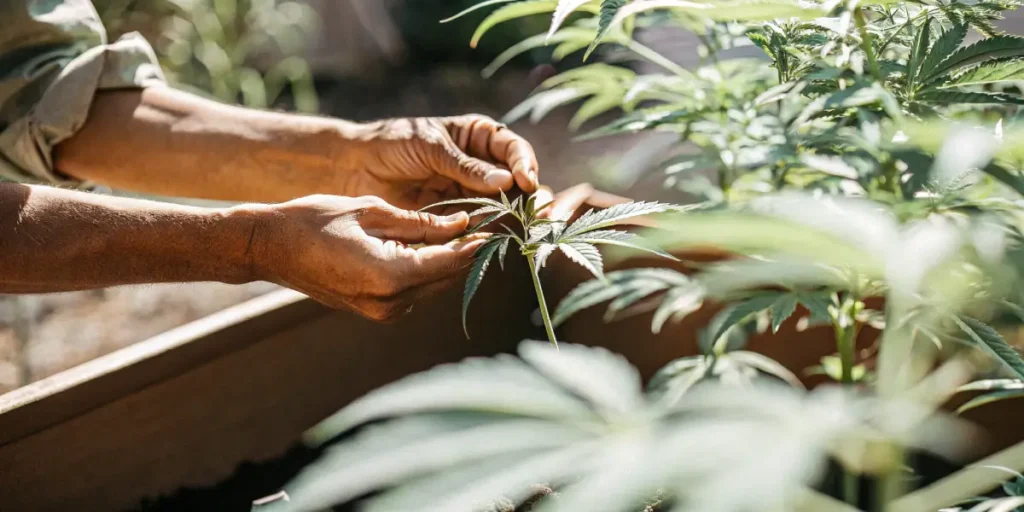
Step-by-Step Cannabis Topping Tutorial for Beginners
Begin by gathering your tools. You’ll need a pair of sharp scissors or pruning shears. Clean them with alcohol to prevent infections. Hygiene is vital in plant care. This prevents any disease from spreading to your cannabis plants.
Identify the top of the plant where the new growth is happening. This is usually the highest point on the plant. Carefully make a clean cut above the node, ensuring you don’t damage the leaves below. This cut will encourage the plant to grow two new main stems.
After making the cut, provide your plant with adequate care to ensure a swift recovery. This includes maintaining a proper watering schedule and providing the right nutrients. Monitoring these aspects is part of the step-by-step cannabis topping tutorial for beginners, ensuring your plant can bounce back stronger.
Additionally, keep your plant’s environment optimal for recovery. Ensure it receives enough light, as this is crucial for photosynthesis and regrowth. Monitoring environmental factors like temperature and humidity can support a healthy recovery, leading to successful implementation of topping techniques.
Best Practices for Topping Cannabis for Beginners
Always maintain cleanliness. Use sterilized tools to avoid infections. It’s also recommended to top your plants early in the day. This allows them to heal and recover under natural light. Natural light helps boost the plant’s recovery process.
Consider the strain you are working with. Some strains, like Critical Daddy Purple from Blimburn Seeds, are more forgiving and can handle stress better. Others may require a gentler approach. Researching your strain’s characteristics can guide your topping technique.
Another best practice for topping cannabis for beginners is to observe your plant’s reaction post-topping. Each plant may respond differently, and understanding its specific needs can help you refine your approach. Adjust your care routine based on how well your plant recovers and grows.
Furthermore, take the time to document your topping process and results. Keeping a grow journal can help track the effects of different techniques and conditions. This record-keeping can be invaluable for future grows and for sharing insights with other growers seeking cannabis plant topping tips for novice growers.
Common Mistakes and How to Avoid Them
One common mistake is topping too early. Young plants might not be strong enough to recover from the stress of topping. Ensure your plant has at least 3 to 5 nodes before attempting this technique. This gives it a solid foundation for regrowth.
Another pitfall is cutting too low. Always cut above the node to prevent stunting growth. Cutting too close to the node can damage the plant’s ability to grow new stems. Keep your cuts clean and precise for the best results.
Additionally, overlooking the importance of sterilizing your tools can lead to infections that can harm your plants. Always ensure that your tools are clean before and after each use. This small step is critical in maintaining plant health and avoiding unnecessary stress.
Lastly, avoid rushing the recovery process. Allow your plant ample time to heal between toppings. This patience is key in how to top cannabis plants for first-time growers, as it ensures your plant remains robust and capable of handling multiple toppings throughout its growth cycle.
Recommended Strains for Topping
Choosing the right strain can make topping more effective. Bruce Banner 3 from Blimburn Seeds is known for its resilience and high yield potential. It responds well to topping, making it a great choice for beginners.
Girl Scout Cookies is another strain worth considering. Its structure makes it ideal for those looking to practice topping. It’s forgiving and produces excellent yields when topped correctly.
Critical Daddy Purple not only offers impressive yields but also provides a great opportunity for beginners to practice and hone their topping skills. Its forgiving nature makes it an excellent choice for those new to cannabis cultivation.
Moreover, researching other strains with a reputation for thriving under topping can broaden your options. Strains that are naturally bushy or exhibit rapid growth tend to respond well to topping, enhancing the overall effectiveness of these cannabis plant topping tips for novice growers.
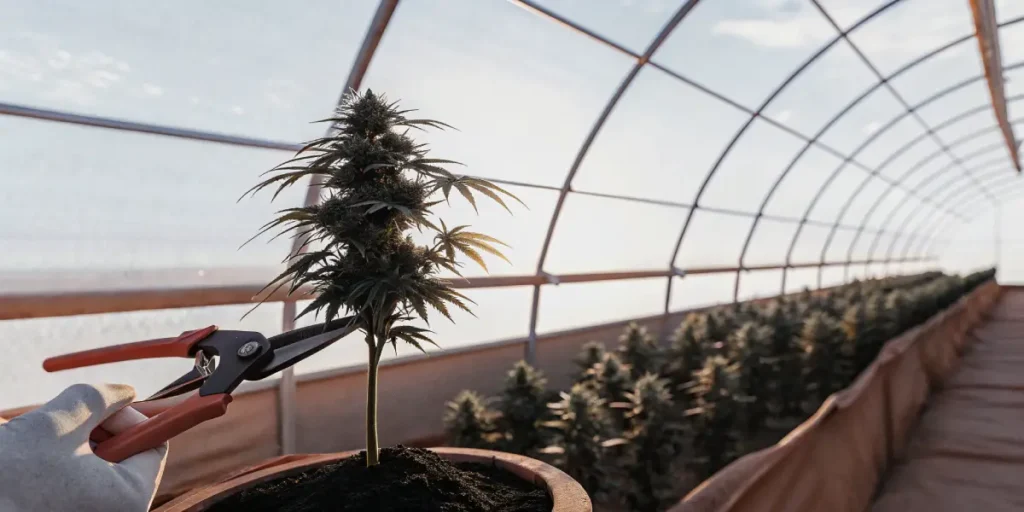
FAQs: Cannabis Topping Guide for Beginners
What is the main purpose of topping cannabis plants?
The primary purpose of topping is to increase yields by encouraging the plant to grow more colas. By cutting the main stem, you stimulate the plant to spread its energy across more branches, resulting in a bushier structure and more buds.
This technique also helps in optimizing light exposure. With more branches, each part of the plant can receive adequate light, which is essential for growth. This method is a cornerstone in many growers’ strategies to maximize their harvest.
Besides to boosting yields, topping can also improve the overall health of the plant. By managing the plant’s growth, you prevent it from becoming too top-heavy, which can lead to structural issues. This preventative measure is an integral part of a beginner’s guide to topping cannabis plants.
Furthermore, topping can enhance the plant’s ability to handle outdoor conditions by promoting a denser canopy. This additional foliage can offer some protection from environmental stressors, contributing to the resilience of your crop.
How do I know if my plant is ready for topping?
Look for the development of 3 to 5 nodes. A node is where leaves grow from the stem. Once your cannabis plant reaches this stage, it is typically ready to be topped. This indicates the plant is strong enough to recover from the topping process.
Patience is crucial. Rushing to top your plant can lead to stunted growth and reduced yields. Waiting for the right moment ensures your plant can handle the stress and grow back stronger.
Observing your plant’s overall health is also essential before proceeding with topping. Ensure that it is free from pests and diseases, as these can impede recovery. Healthy plants are more likely to bounce back quickly from the topping process.
Additionally, consider the growth rate of your plant. Faster-growing plants may be ready for topping sooner than those that develop at a slower pace. Adjust your timing based on these observations for the best outcomes.
Can all cannabis strains be topped?
While most strains can be topped, some respond better than others. Strains like Bruce Banner 3 and Girl Scout Cookies from Blimburn Seeds are particularly known for thriving under topping. Their genetic makeup makes them resilient to this technique.
However, some strains may require gentler handling. It’s always best to research your particular strain to understand how it might react to topping. This knowledge helps tailor your approach for the best results.
Additionally, some indica-dominant strains may naturally grow bushier and require less intervention through topping. Understanding these characteristics can help you decide whether topping is necessary for your particular strain.
Researching strain-specific forums and grower communities can provide further insights into the effectiveness of topping for your selected strain. Sharing experiences and tips can enhance your understanding of how to top cannabis plants for first-time growers.
What tools do I need for topping cannabis plants?
You’ll need a pair of sharp scissors or pruning shears. Ensure these tools are sterilized with alcohol to prevent infections. Keeping your tools clean is vital in maintaining plant health and preventing disease.
Using dull tools can damage the plant, leading to jagged cuts that don’t heal well. Investing in quality gardening tools will make the topping process smoother and more effective.
Besides to scissors or pruning shears, consider having a magnifying glass on hand. This can help you make more precise cuts, especially on smaller or intricate parts of the plant.
Moreover, having a clean workspace and a container for plant waste can help keep your growing environment tidy. Proper disposal of plant material helps prevent the spread of potential pests and diseases.
What should I do after topping my cannabis plant?
After topping, monitor your plant closely for signs of stress or new growth. Ensure it receives adequate light and nutrients to support its recovery. This care helps the plant bounce back quickly and continue growing robustly.
Watch for any adverse reactions such as drooping leaves. If this occurs, adjust your care routine accordingly. Providing consistent care post-topping ensures your plant remains healthy and productive.
Additionally, ensure your plant has enough space to support its new growth pattern. As the plant develops more branches, it may require more room to thrive. Adjusting its environment is key to facilitating healthy development post-topping.
Moreover, consider applying a light feeding of nutrients tailored to the vegetative stage. This can provide an extra boost to the plant’s recovery process, promoting robust regrowth and a successful topping experience.


